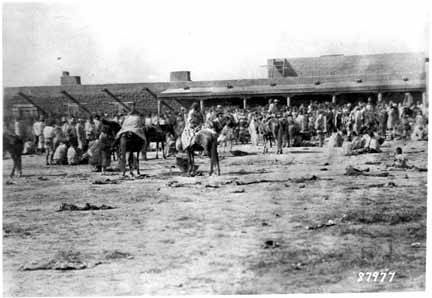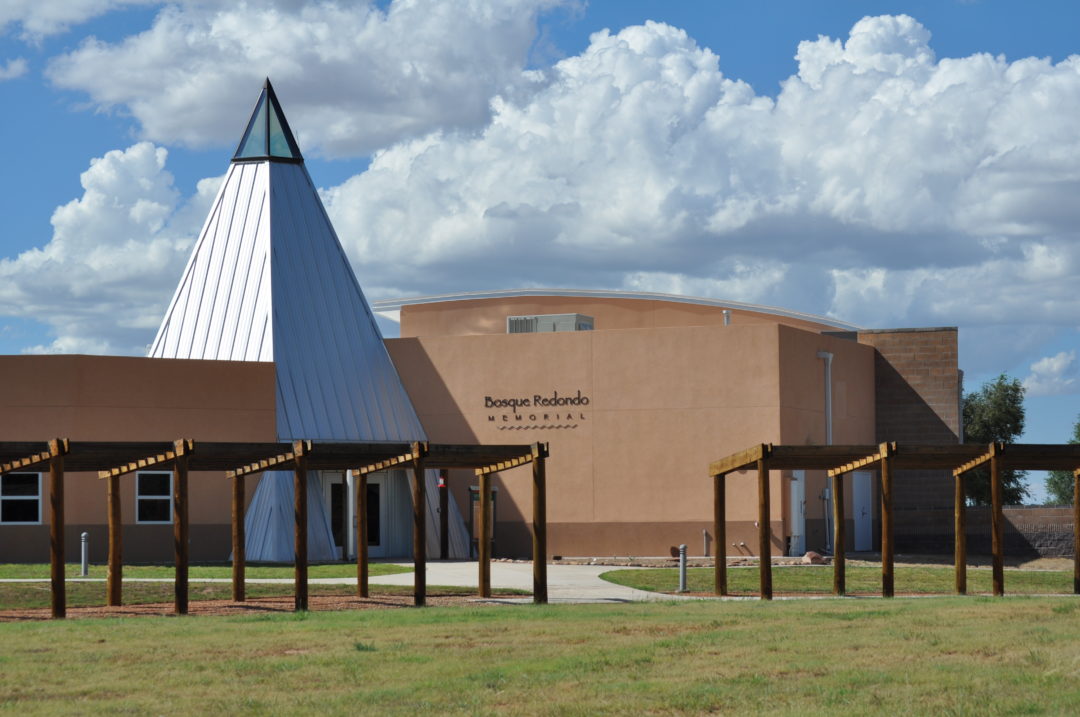As author Jordan Eddy writes in the online arts magazine Hyperallergic, a group of seventeen Diné youth, with their chaperones, stopped at the Bosque Redondo Memorial at Fort Sumner Historic Site (New Mexico), thirty-two years ago, on June 27, 1990. Their leaders inform them that they would be experiencing “their own history.” This clearly did not happen. Before they left the historic site, these Diné youth passed a note to the museum staff. As Jordan Eddy tells in Hyperallergic, their note in part read:
“We the young generation of the Diné (Navajo) […] find Fort Sumner’s Historical site discriminating and not telling the true story behind what really happened to our ancestors in 1864-1868. […] We therefore declare that the museum show and tell the true history of the Navajos and the United States military.” [June 27, 1990]
Early this spring on May 28, 2022, many of those same Diné youth, now adults, finally got what they asked for, an accurate telling about “the Long Walk,” attemped ethnic cleansing and the near four year incarceration of the Navajo at Bosque Redondo Indian Reservation (aka Hwéeldi, in De Baca County). The New Mexico Historic Sites’ (NMHS) completely redesigned exhibit is entitled “Bosque Redondo: A Place of Suffering…A Place of Survival.” In attendence for the grand opening where hundreds of Navajo (Diné) and Mescalero Apache (Ndé) community members. As requested some thirty years earlier, the new semi-permanent exhibit tell this difficult chapter in America’s history, and “shows and tells the true history,” concerning Bosque Redondo. This includes telling what had been previously silenced. Many indigenous voices were included. To read the remarkable story regarding the protesting Diné youth, who visited the historic site in 1990, read here.
What’s the story behind Bosque Redondo? It is a story of trauma–mass deportation, cultural destruction and attempted ethnic cleansing–within the broader region of the Four Corners Area (a region of the Southwestern U.S., including southeastern Utah), which is to this day very difficult for the Diné to talk about. This story ended in 1868 with a treaty between the US Government and the Navajo which established the Naabeehó Bináhásdzo Navajo Reservation. Known today as the Navajo Nation, the largest Indian reservation in the United States. Utah’s portion of the Navajo Nation, added after 1884, includes approximately 7,000 Diné residents (not to mention thousands of Navajo living across Utah).
As the Smithsonian Institute describes, the “Navajo became the only Native Nation to use a treaty to escape removal and return to their home[lands].” See the original and transcript of the treaty and learn more about historical context, as offered by the Smithsonian National Museum of the American Indian. Although far from the populated areas of Utah, this too is a story of Utah.

The Bosque Redondo story begins in 1864, when thousands of Navajo living between the four sacred mountains–Hesperus Peak (Dibé Ntsaa), Mount Blanca (Sisnaajini), San Francisco (Dookʼoʼoosłííd) and Mount Taylor (Tsoozil) what is today southeastern Utah, western Colorado, northeast Arizona and northwest New Mexico–were terrorized and forced to abandon their homelands, by a series of US Army military “scorched-earth” campaigns, where Navajo livestock was killed and stolen, their water supplies poisoned, and their villages and agricultural fields burned and destroyed. Approximately 8,000 to 11,000 Diné men, women and children were then marched over 300 miles, south and east, to Bosque Redondo, known thereafter as “The Long Walk,”to be imprisoned, along with members of the Mescalero Apache (Ndé) tribe. This was the missing and silenced history the seventeen Diné youth in 1990 wanted to hear and see at Bosque Redondo.
This imprisionment ends in 1868–with never enough water, or wood for heating and cooking, or food rations (coffee, rancid meat and flour), a failed attempt at cultural genicide (not allowing ceremonies, singing songs, or praying in their own language), a failed attempt at teach Anglo-American farming, and with quarter of the population either dying or dead due to malnourishment—this forced removal was acknowledged a failure by the U.S. Government, and via astute tribal negotiations, including Navajo women standing up to their US Army captors, the Navajo were able to leave their incarceration at Bosque Redondo, and return northward to their Four Corners homelands.
To go even deeper into this history, watch Diné high school students Kami Atcitty’s, Kaia Jay’s and Esperanza Lee’s film The Long Walk of the Navajo: The 1884 Encounter at Hwéeldi and the Impact on the Dinétah (2016) produced for the Utah’s National History Day program.
There are many other efforts afoot to “show and tell the true history” concerning Native America, across the American West and the United States.
In Utah a recent example was the Utah Division of Indian Affairs and over two dozen history partners, who gathered together in Ogden, Utah for a second “Railroads in Native America Gathering.” The gathering offered many Native American perspectives concerning the 160+ years of impact the railroad system had on Indigenous peoples.
Speaking about the history of the Navajo Nation–including a more detailed telling of the above story–Paul Spruhan, Assistant Attorney General for the Navajo Nation, describes how the Santa Fe Railroad (the Atchison & Topeka Railroad Company) played a major role in the evolving and confusing boundaries and borders of the Navajo Nation. Thereafter, Dr. Andrew Curley (Diné, Univ. of Arizona, School of Geography, Development & Environment) responds to Spruhan’s presentation. To watch Paul Spruhan’s and Dr. Andrew Curley’s May 21, 2022 presentations CLICK HERE, then scroll down to “Session 5: Along the Rails in the Southwest: Indigeneity & Community Experience.”

